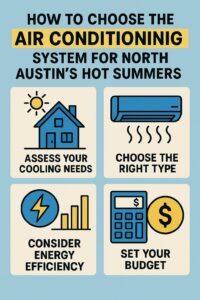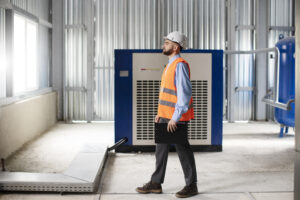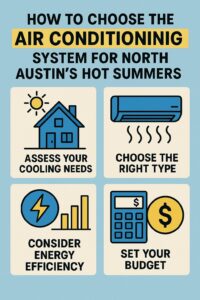When the temperature soars in North Austin, it’s crucial to have an air conditioning system that can keep your home cool and comfortable. The scorching Texas summer heat can be relentless, and choosing the right air conditioning service for your home can make all the difference in your energy bills and overall comfort. With so many options available, it can be overwhelming to pick the best one. This guide will walk you through the essential factors to consider when selecting an air conditioning system tailored to North Austin’s hot summers.
Understanding the Importance of the Right AC System
Before diving into the specific types of air conditioners available, it’s important to understand why the right AC system matters for your home in North Austin.
The Texas Heat and Humidity
North Austin experiences high temperatures during the summer, often exceeding 100°F (38°C). The combination of high heat and humidity can be uncomfortable and taxing on air conditioning systems that aren’t designed to handle such conditions. An improperly sized or inefficient AC unit will not only fail to cool your home effectively but also consume excessive energy, increasing your utility bills.

The Need for Energy Efficiency
The long summer season in Texas means that your air conditioning system will be running for extended periods. Choosing an energy-efficient system can help you save money while keeping your home comfortable. Look for units with high Seasonal Energy Efficiency Ratio (SEER) ratings, which indicate better energy efficiency.
Factors to Consider When Choosing an AC System
There are several factors to consider when choosing the best air conditioning system for your home in North Austin. Each factor plays a role in ensuring you get the right unit that matches your needs, budget, and energy efficiency requirements.
1. AC Size: Proper Sizing for Your Home
One of the most important aspects of choosing an AC system is getting the right size for your home. An AC that is too small will struggle to cool your home effectively, while an oversized unit will cycle on and off frequently, leading to wasted energy and unnecessary wear on the system.
How to Determine the Right Size
The size of an air conditioning unit is measured in tons, with one ton equal to 12,000 British Thermal Units (BTUs) per hour. To determine the right size for your home, you need to calculate the square footage of your living space and consider other factors such as insulation, window placement, and local climate. Generally, a 1.5-ton unit can cover 600-900 square feet, while a 3-ton unit is suitable for homes ranging from 1,500 to 2,000 square feet.
Professional Load Calculation
To ensure the most accurate size, it’s recommended to have a professional perform a Manual J load calculation. This calculation takes into account your home’s specific characteristics, including the number of windows, insulation type, and orientation to the sun.
2. Types of Air Conditioning Systems
There are several different types of air conditioning systems available, each suited to different needs and types of homes. Here are the most common options:
Central Air Conditioning
Central air conditioning systems are the most common type of cooling system for homes in North Austin. They use a network of ducts to distribute cool air throughout the house. These systems are ideal for larger homes or homes with multiple rooms. They are generally more energy-efficient than window units and provide uniform cooling across the entire home.
Ductless Mini-Split Systems
Ductless mini-split systems are another option for cooling homes in North Austin. These systems consist of an outdoor unit connected to one or more indoor air handling units. Since they don’t require ductwork, they are perfect for homes without existing ducts or for room additions. Mini-split systems are also energy-efficient and offer zone cooling, allowing you to control the temperature in different areas of your home independently.
Window Units
Window air conditioners are compact units that fit into a window and are ideal for cooling individual rooms. While they are less energy-efficient than central AC or ductless mini-splits, they are affordable and easy to install. If you live in a small apartment or need to cool just one room, a window unit can be a good option.
Heat Pumps
Heat pumps work similarly to air conditioners but can also provide heating during the colder months. They are an efficient option for homes in areas with mild winters and hot summers like North Austin. Heat pumps are available in both ducted and ductless configurations.

3. SEER Rating: Understanding Energy Efficiency
Energy efficiency is critical when selecting an air conditioning system. The SEER rating is a measure of an AC unit’s cooling output divided by the energy it consumes. The higher the SEER rating, the more energy-efficient the system is.
Minimum SEER Requirements
In North Austin, the minimum SEER rating required for newly installed AC systems is typically 14 SEER for residential units. However, for better energy efficiency, look for units with SEER ratings of 16 or higher. High-SEER units are more expensive upfront but can save you money over time by reducing your energy bills.
4. Air Quality and Filtration
The air quality inside your home is another critical factor, especially in areas with high humidity and allergens like North Austin. Many modern AC systems come with advanced filtration systems that help improve indoor air quality by removing dust, pollen, pet dander, and other airborne particles.
Features to Look for:
- HEPA Filters: High-efficiency particulate air (HEPA) filters can trap very fine particles and improve air quality.
- UV Light Systems: Some air conditioners come with ultraviolet light systems that help kill bacteria, viruses, and mold that can grow inside the AC unit.
- Dehumidifiers: Integrated dehumidifiers can help remove excess moisture from the air, which is particularly important in a humid climate like Austin.
5. Installation and Maintenance
Proper installation and regular maintenance are essential for keeping your AC system running efficiently. Improper installation can lead to reduced performance and higher energy bills, so always hire a licensed professional to install your AC system.
Routine Maintenance
Schedule regular maintenance for your AC system to ensure it operates efficiently throughout the summer. This includes tasks like cleaning or replacing filters, checking refrigerant levels, and inspecting ducts for leaks. Regular maintenance can extend the lifespan of your unit and prevent costly repairs.
6. Budget and Cost Considerations
The upfront cost of purchasing and installing an air conditioning system can vary greatly depending on the size, type, and energy efficiency of the unit. However, don’t forget to factor in the long-term operating costs. While a higher-SEER unit might cost more initially, it can save you money in energy bills over the life of the system.
Financing Options
Many HVAC companies offer financing options to help spread the cost of installation. This can make it easier to upgrade to a more efficient system without paying the full cost upfront.
Common Mistakes to Avoid
When choosing an air conditioning system for your home, avoid these common mistakes:
- Ignoring the Size of the Unit: Always get a professional load calculation to avoid selecting a unit that is too big or too small for your home.
- Opting for the Cheapest Option: While cheaper units may seem like a good deal, they often have higher operating costs and shorter lifespans. Invest in quality for long-term savings.
- Neglecting Regular Maintenance: Regular maintenance is key to ensuring your AC system runs efficiently. Skipping this step can result in unnecessary repairs and higher energy bills.
Conclusion
Choosing the best air conditioning system for your home in North Austin’s hot summers is a crucial decision that impacts both your comfort and your energy bills. By considering factors like proper sizing, energy efficiency, air quality, and maintenance, you can make an informed choice that suits your needs and budget. Whether you opt for a central AC system, a ductless mini-split, or a heat pump, investing in a high-quality, energy-efficient system will ensure you stay cool throughout the hot Austin summers.




